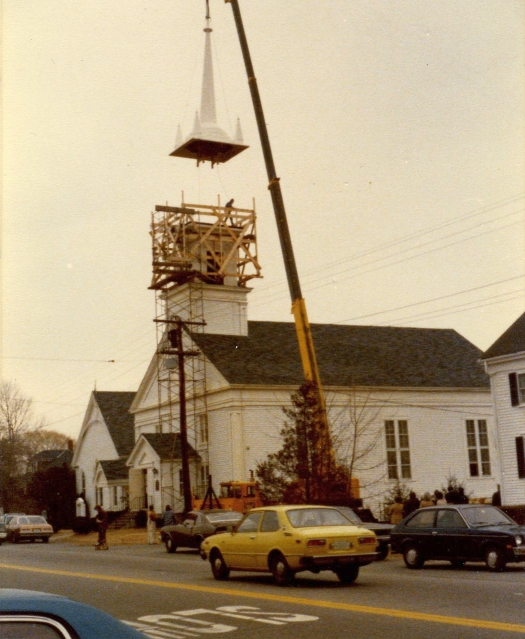Hampton Congregational Parish
Gets Early Easter Present
By John Hart, Sunday News Correspondent
[Photos by John Hart]
New Hampshire Sunday News, April 6, 1980
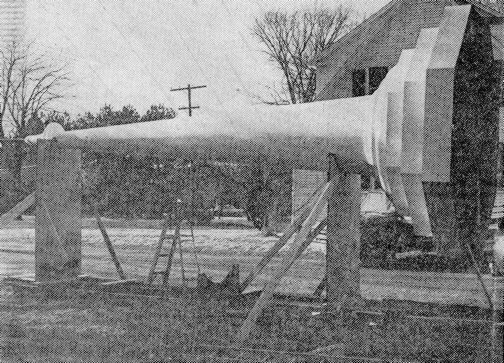
of Hampton awaits the difficult journey to it final destination
HAMPTON, April 5 — There was no resurrecting the old “rotted” steeple of the First Congregational Church of Hampton, so a new one was built in time for this Easter Sunday.
The steeple’s new fiberglass spire, weighing 2,000 pounds, was hoisted to the church’s top last Wednesday during Holy Week. More than 100 members- of the congregation along with other spectators were on hand for the event. This is the fourth steeple to top the old meeting house built in 1844.
Paterson Construction Co. of Portsmouth built the new steeple, and on a sub-contract, Ashton Norton of Hampton, a fiberglass boat builder, manufactured the spire.
The Rev. James A. Barclay is pastor of the Church, which was founded in 1638. He said, from the days of the first settlers to modern times. “the spirit of Congregationalism has flourished in Hampton.”
This present location is one of six meeting houses the 342-year-old congregation has used for services. The First Congregational Church was founded by the Rev. Stephen Bachiler founder of the town of Hampton [in October 1638].
Bachiler and 55 settlers from Massachusetts laid out, Winnacunnet Plantation and organized what is now the oldest Congregationalist Society in New Hampshire.
Religion Came First
Before their homes were finished, the original settlers of Hampton built their first log religious meeting house. Barclay said. The bell of that house would summon the worshippers to services, and the spire was a landmark for them.
“The steeple with its spire is a symbol of our religious freedom, a symbol of our commitment.” said Rev. Barclay. “in my opinion, what goes on under the steeple is important. So long as we have commitment, America will be strong.” he added.
Members of the Church have been saving for four years for the new steeple that cost more than $20,000. That cost compares to $900 the Church paid for its second steeple in 1888 according to Samuel Towle one of Barclay’s parishioners.
After four years of saving, the congregation was still 50 percent short of the needed cash, Rev. Barclay said. But based on “faith in the Lord it was decided to go forth and build the steeple,” despite the shortfall of money, he said,
The balance of the needed money “came from gifts of many people in the community (some of whom are not members of the church),” he added.
Humbling Experience
Mrs. Laura MacLean the church’s historian, and her husband were on hand for the hoisting of the new spire. “As you lift your eyes and see this spire, you get a heeling elation” she said, adding “by contrast you look down, realize how small you are, and feel humble.
Mr. MacLean said the steeple had three sections -— clock tower, bell tower (neither of which exist now), and the spire with its weathervane.
A spire on top of a house of worship served as a landmark in the colonial days.
Bells in the steeples summoned the church members for prayers and religious observances; and at times, signaled disaster and warnings of attack.
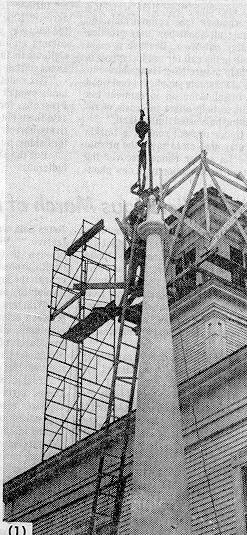
cable to the spire’s tip which is topped
by a lightning road.
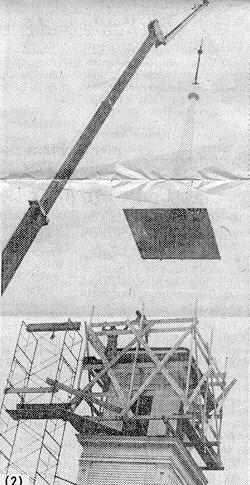
off the ground and hovers above its
new foundation.
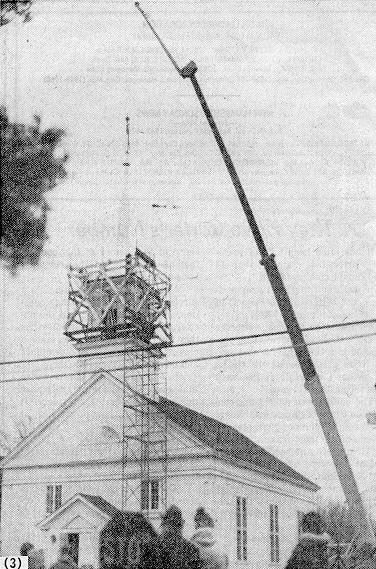
the attractively austere lines of the old church.
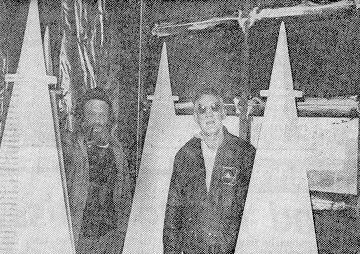
Pylons for the spire surround Ashton Norton (right) and his helper, Bradley Bailey. Norton and Bailey spent two months building the fiberglass spire and four pylons. Norton, a former state representative, is in the fiberglass-boat building business.
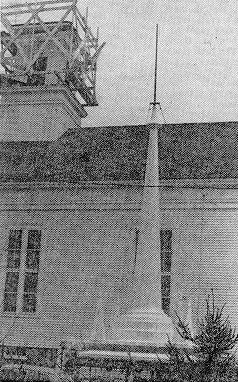
Resembling a giant upside-down ice-cream cone, the new church spire is ready for hoisting into place atop the new steeple.
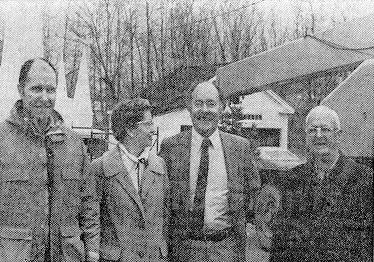
Discussing the new spire with their pastor, the Rev. James A. Barclay (second from right), are members of Hampton’s First Congregational Church, from left, Curtis Wormwood; Mrs. Laura MacLean, the church historian, and her husband, Maynard MacLean (right).

A gallery of interested Hamptonians watch the proceedings from a safe distance.
